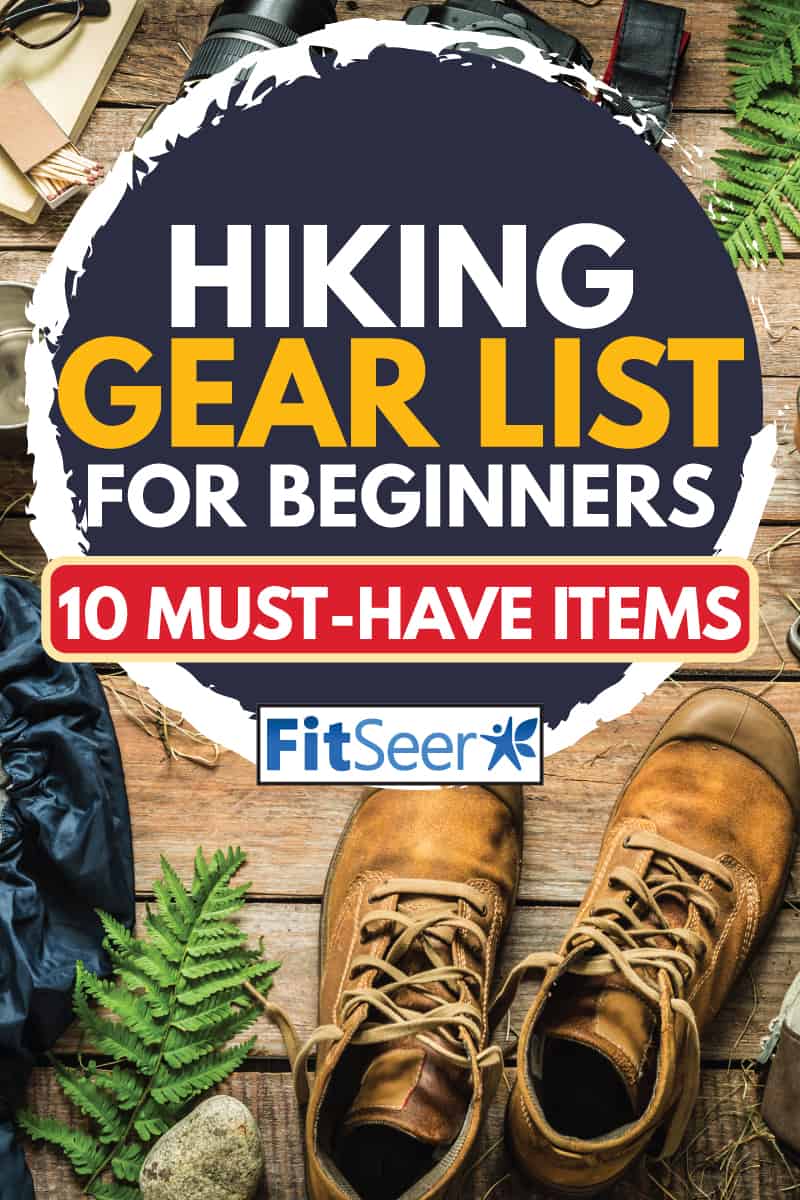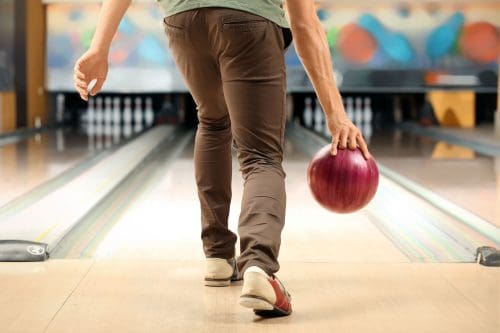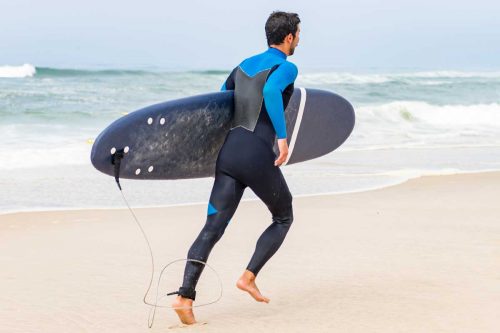Are you thinking of beginning hiking? Does the idea of getting your blood pumping while enjoying beautiful outdoor vistas light you up? Hiking is a great activity for those who want to get outdoors and spend some time in nature while getting exercise simultaneously. But what are the essential gear requirements to get you started? We've researched the necessities to get you started.
This list of beginner essentials will get you out on the trail for your first hikes.
- Hiking backpack
- Navigation supplies: GPS device, map, compass
- Sunscreen
- Weather appropriate clothing
- Hiking boots or shoes
- First-aid supplies
- Food and water
- Headlamp or flashlight
- Knife or multi-tool
- Firestarter or matches
While this list is not all-inclusive, it's a good starter package for a beginner hiker. Read on to learn why you need each item on the list. We'll also provide additional tips for newbie hikers.

Beginners' Hiking Gear
Hiking Backpack
A backpack is a core item for your hiking adventures. You need this item to carry all the other things you'll need. Most beginners will start with day hikes. You don't need anything too large. For short starter hikes, a backpack that holds 11-20 liters is a good choice. Try different backpacks on to see which fit your body the most comfortably. Waist straps and chest straps help distribute weight and make carrying your backpack easier. A backpack with space for a water bladder is a great option.
This small 13-liter backpack is a lightweight starter option. It will hold a water bladder.
Click here to see this backpack on Amazon.
If you need a little larger backpack check out this 25-liter option. It also has a chest and a waist strap.
Click here to see this backpack on Amazon.
Navigation supplies: GPS device, map, compass
GPS devices contain electronic maps and can guide you through the wilderness. Many people use GPS apps on their phones to aid in navigation. While these are amazing technological tools, technology is never foolproof. These devices will require batteries or the ability to charge. You'll need a back up in cases of equipment failure or running out of charge or battery.
Click here to see this GPS on Amazon.
Maps of the area you'll be hiking are a backup or alternative to a GPS unit. Topographical maps will give you valuable information regarding the terrain. Keep your map in a dry-bag to protect it from the elements.
The final navigation item to carry is a compass. A compass used with your map allows you to calculate distance and bearing. If you've never used a compass, spend some time learning basic land navigation with a map and compass before heading out for a hike.
Click here to see the compass on Amazon.
Sunscreen
To protect your skin from the sun while out on a hike, you'll need sunscreen. A broad-spectrum sunscreen will protect you from both UVA and UVB rays from the sun. These are the rays that can cause skin cancer. Choose a product with an SPF of at least 30 and apply at least 20 minutes before you head out to hike.
Click here to see this cute little sunscreen pack that is perfect for throwing in your backpack.
Weather appropriate clothing
Check the weather forecast before your hike and make sure you plan accordingly. Dressing in layers allows you to adjust as the weather changes or your body warms up. You may start cool but need to shed layers as you begin moving on the trail. Consider moisture wicking items that won't stay wet against your skin. Vise-versa, when you approach the summit, the temperature will drop, so you'll want an extra layer while you admire the views.
Click here to see these hiking pants on Amazon.
Click here to see these half-zip shirts on Amazon.
Hiking boots or shoes
Choose your footwear according to the terrain you'll be hiking. Hiking shoes or trail running shoes are fine for easy trails. For rugged terrain, consider hiking boots that support your ankle to prevent sprains.
Click here to see this hiking shoe on Amazon.
Click here to see these hiking boots on Amazon.
First-aid supplies
A small, basic first aid kit should include:
- bandaids
- gauze pads and dressings
- tape
- antiseptic
- blister prevention and treatment
- gloves
- tweezers
- needle
- over the counter pain killers and anti-inflammatories
- anti-diarrheal
- anti-histamine
- antibiotic ointment
- roller bandage
Your first aid kit should enable you to deal with minor injuries or emergencies until you can get help.
Click here to see this compact first-aid kit on Amazon.
Food and water
Plan to carry enough water to last for the length of time you will be hiking. A water reservoir that fits in your backpack is an easy option, but refillable water bottles can be carried as well. You'll get thirsty out hiking, and staying hydrated is very important. If the weather is hot, you'll dehydrate quickly—plan for two liters per person for each day of hiking.
Foods can be simple and pre-packaged. Energy bars, jerky, nuts are all easily packable options. Think about foods that are small and portable but energy-dense.
Click here to see these bars on Amazon.
Click here to see this water bladder on Amazon.
Headlamp or flashlight
Hopefully, you'll never need this item, but it's one of those "just in case" emergency items. Should you get lost, you'll be very glad to have a headlamp or flashlight with you. Headlamps allow you to use your light source hands-free, but a flashlight is better than nothing. Remember to check your batteries before heading out to hike and carry replacement batteries in your backpack.
Click here to see this headlamp on Amazon.
Knife or multi-tool
Knives can be used for many situations. Multi-tools are even more versatile as they expand on the basic knife with other easily carried tools.
Click here to see this multi-tool on Amazon.
Firestarter or matches
Many of the items in your backpack will be for emergency use only. A firestarter or matches will allow you to start a fire for an emergency. You may need a fire to cook or keep warm. If you chose to carry matches, ensure they are stored in a waterproof container.
Click here to see this firestarter on Amazon.
How fast does the average person hike?
The average hiker will cover about two miles each hour. A few factors can impact your hiking pace. Hills, high elevations, and the surface you are hiking on can alter your speed. Carrying a heavy backpack will also slow your pace. Consider your overall physical condition. New hikers will be slower than an experienced, well-conditioned hiker.
There are two numbers to look at when considering your hiking speed - overall average and moving average. The overall average refers to the entire time you have been out on the trail from start to finish. This time will include rest breaks for eating, toileting, etc. Moving average is the time actually on your feet hiking. You'll deduct any time for rest breaks.
How far can a beginner hike in a day?
As a beginning hiker, you should aim for a hike that lasts about two to three hours or five to six miles. Attempting to move too far too fast will result in muscle soreness, fatigue, and injuries. Plan for plenty of rest breaks during your hike.
Several factors can affect the distance you can hike:
- Your individual fitness level.
- Terrain and elevation.
- Weather - heat, muddy trails.
- How heavy your backpack is.
Plan for your initial hikes to be shorter and look for flat terrain. Once you build up stamina, you can take on longer distances.
Should you hike alone (and how to safely)?
Hiking alone presents some specific challenges. Consider your personal attitude and fitness level when deciding if hiking alone is right for you. If you decide to hike by yourself, follow these guidelines to ensure the safest experience.
Choose a well-marked and maintained trail
Hiking alone is not the time to venture out and off the beaten path. You want to make sure you know where you are going and will not get lost. Choose a trail that is a bit easier than your current ability and avoid trails that will require crossing water.
Tell someone where you are going
Let a friend or family member know your plans for the day. Specifically what time you'll be setting out and how long you expect the hike to take. Check-in with them once you have safely completed your hike. If you don't report within a reasonable timeline having someone know where to look for you is imperative.
Be prepared for emergencies
If you are solo hiking, make sure you have your backpack with emergency items. Ensuring your first aid kit is up to date and having your basic supplies will prepare you if something goes wrong. Bring a few extra items like an extra layer of clothing, food, and water in case an issue would require you to stay out on the trail longer than you'd expected.
Check the weather
Make sure the day of your solo hike shows a clear weather report. You don't want to be surprised by an unexpected storm.
Do not wear headphones
When on the trail by yourself, you want to make sure to stay alert. You'll want to be able to hear anything approaching you be it human or animal.
Be aware of possible wildlife
Know if you are hiking in an area with potential predators and how to handle the possibility of an encounter. Carry bear spray in your backpack. Try to make a little extra noise while you are hiking to avoid accidentally surprising an animal.
In Conclusion
Hiking is a wonderful activity that increases physical fitness while allowing you to experience the beauty of nature. Prepare for your hiking adventures by gathering basic hiking equipment and planning your hikes. Spend some time familiarizing yourself with basic navigation techniques and how to use your equipment to ensure you are ready for anything that happens while you are out on the trail.
Please also check out our related hiking post:
https://fitseer.com/how-to-hike-without-getting-tired-7-crucial-tips/


















![Read more about the article How Can I Practice Basketball Indoors? [5 Suggestions]](https://fitseer.com/wp-content/uploads/2022/03/Shot-of-basketball-players-playing-basketball-indoor-500x333.jpg)


